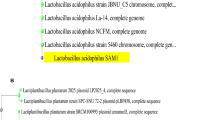Abstract
Ethnic people of the Himalayan regions of India, Nepal, Bhutan and China consume a variety of indigenous fermented milk products made from cows milk as well as yaks milk. These lesser-known ethnic fermented foods are dahi, mohi, chhurpi, somar, philu and shyow. The population of lactic acid bacteria (LAB) ranged from 107 to 108 cfu/g in these Himalayan milk products. A total of 128 isolates of LAB were isolated from 58 samples of ethnic fermented milk products collected from different places of India, Nepal and Bhutan. Based on phenotypic characterization including API sugar test, the dominant lactic acid bacteria were identified as Lactobacillus bifermentans, Lactobacillus paracasei subsp. pseudoplantarum, Lactobacillus kefir, Lactobacillus hilgardii, Lactobacillus alimentarius, Lactobacillus paracasei subsp. paracasei, Lactobacillus plantarum, Lactococcus lactis subsp. lactis, Lactococcus lactis subsp. cremoris and Enterococcus faecium. LAB produced a wide spectrum of enzymes and showed high galactosidase, leucine-arylamidase and phosphatase activities. They showed antagonistic properties against selected Gram-negative bacteria. None of the strains produced bacteriocin and biogenic amines under the test conditions used. Most strains of LAB coagulated skim milk with a moderate drop in pH. Some strains of LAB showed a high degree of hydrophobicity, suggesting these strains may have useful adhesive potential. This paper is the first report on functional lactic acid bacterial composition in some lesser-known ethnic fermented milk products of the Himalayas.
Similar content being viewed by others
References
Abdelgadir WS, Hamad SH, Møller PL, Jakobsen M (2001) Characterisation of the dominant microbiota of Sudanese fermented milk Rob. Int Dairy J 11:63–70
Badis A, Guetarni D, Moussa-Boudjemaa B, Henni DE, Tornadijo ME, Kihal M (2004) Identification of cultivable lactic acid bacteria isolated from Algerian raw goat’s milk and evaluation of their technological properties. Food Microbiol 21:343–349
Beukes EM, Bester BH, Mostert JF (2001) The microbiology of South African traditional fermented milks. Int J Food Microbiol. 63:189–197
Bover-Cid S, Holzapfel WH (1999) Improved screening procedure for biogenic amine production by lactic acid bacteria. Int J Food Microbiol 53:33–41
Buchenhüskes HJ (1993) Selection criteria for lactic acid bacteria to be used as starter cultures in various food commodities. FEMS Microbiol Rev 12:253–272
Chammas GI, Saliba R, Corrieu G, Béal C (2006) Characterisation of lactic acid bacteria isolated from fermented milk “laban”. Int J Food Microbiol 110:52–61
Dewan S, Tamang JP (2006) Microbial and analytical characterization of Chhu, a traditional fermented milk product of the Sikkim Himalayas. J Sci Indus Res 65:747–752
Durlu-Ozkaya F, Xanthopoulos V, Tunaï N, Litopoulou-Tzanetaki E (2001) Technologically important properties of lactic acid bacteria isolated from Beyaz cheese made from raw ewes’ milk. J Appl Microbiol 91:861–870
Dykes GA, Britz TJ, von Holy A (1994) Numerical taxonomy and identification of lactic acid bacteria from spoiled, vacuum packaged Vienna sausages. J Appl Bacteriol 76:246–252
Gran HM, Gadaga HT, Narvhus JA (2003) Utilisation of various starter cultures in the production of Amasi, a Zimbabwean naturally fermented raw milk product. Int J Food Microbiol 88:19–28
Mathara JM, Schillinger U, Kutima PM, Mbugua SK, Holzapfel WH (2004) Isolation, identification and characterization of the dominant microorganisms of kule naoto: the Maasai traditional fermented milk in Kenya. Int J Food Microbiol 94:269–278
Mufandaedza J, Viljoen BC, Feresu SB, Gadaga TH (2006) Antimicrobial properties of lactic acid bacterial and yeast-LAB cultures isolated from traditional fermented milk against pathogenic Escherichia coli and Salmonella enteritidis strains. Int J Food Microbiol 108:146–152
Nostro A, Cannatelli MA, Crisafi G, Musolino AD, Procopio F, Alonzon V (2004) Modifications of hydrophobicity, in vitro adherence and cellular aggregation of Streptococcus mutans by Helichrysum italicum extract. Letters Appl Microbiol 38:423–427
Olasupo NA, Schillinger U, Holzapfel WH (2001) Studies on some technological properties of predominant lactic acid bacteria isolated from Nigerian fermented foods. Food Biotechnol 15(3):157–167
Perez PF, Minnaard Y, Disalvo EA, De Antoni GL (1998) Surface properties of bifidobacteria strains of human origin. Appl Environ Microbiol 64:21–26
Schillinger U, Lücke FK (1989) Antibacterial activity of Lactobacillus sake isolated from meat. Appl Environ Microbiol 55(8):1901–1906
Shah NP (2001) Functional foods from probiotics and prebiotics. Food Technol 55(11):46–53
Sharma DK, Ghosh K, Raquib M, Bhattacharya M (2006) Yak products’ profile: an overview. J Food Sci Technol 43(5):447–452
Tamang JP (2005) Ethnic fermented foods of the Eastern Himalayas. In: The proceeding of the second international conference on “Fermented Foods, Health Status and Social Well-being”. Anand Agricultural University, Anand 17–18 December 2005, pp 19–26
Tamang JP, Dewan S, Thapa S, Olasupo NA, Schillinger U, Holzapfel WH (2000) Identification and enzymatic profiles of predominant lactic acid bacteria isolated from soft-variety chhurpi, a traditional cheese typical of the Sikkim Himalayas. Food Biotechnol 14(1 and 2):99–112
Uhlman L, Schillinger U, Rupnow JR, Holzapfel WH (1992) Identification and characterization of two bacteriocin-producing strains of Lactococcus lactis isolated from vegetables. Int J Food Microbiol 16:141–151
Wood BJB, Holzapfel WH (eds) (1995) The lactic acid bacteria, vol. 2: the genera of lactic acid bacteria. Chapman and Hall, London, p 391
Xanthopoulos V, Petridis D, Tzanetakis N (2001) Characterization and classification of Streptococcus thermophilus and Lactobacillus delbrueckii subsp. bulgaricus strains isolated from traditional Greek yogurts. J Food Sci 66:747–752
Zamfir M, Vancanneyt M, Makras L, Vaningelgem F, Lefebvre K, Pot B, Swings J, De Vuyst L (2006) Biodiversity of lactic acid bacteria in Romanian dairy products. Syst Appl Microbiol 29(6):487–495
Acknowledgement
Authors acknowledge the Department of Biotechnology, Ministry of Science and Technology, Government of India for financial support.
Author information
Authors and Affiliations
Corresponding author
Rights and permissions
About this article
Cite this article
Dewan, S., Tamang, J.P. Dominant lactic acid bacteria and their technological properties isolated from the Himalayan ethnic fermented milk products. Antonie van Leeuwenhoek 92, 343–352 (2007). https://doi.org/10.1007/s10482-007-9163-5
Received:
Accepted:
Published:
Issue Date:
DOI: https://doi.org/10.1007/s10482-007-9163-5




